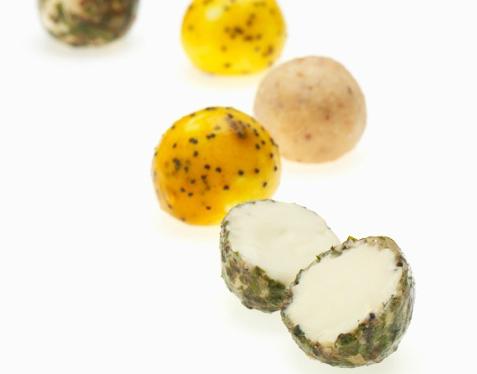Edible packaging could change the way we prepare and store food
These cheese balls are made with edible packaging — making them convenient to carry and to eat.
Many of the foods we eat — from cookies to cereal — are packaged in plastic.
The upside? Plastic is cheap, convenient, and versatile.
The downside? Chemicals from packaging may leach into food. And tons of plastic ends up in both the ocean and in landfills every year.
Now, imagine walking into a grocery store where everything is wrapped in edible, grape-like skins, with no other packaging. You buy what you want, take it home and wash it off like you would an apple. That's the vision of Harvard's David Edwards, who's working to make this futuristic scene a reality.
“My dream is to rethink food and beverage packaging, following the model of nature, in the way that nature packages fruit,” says Edwards.
From soft, edible skins to hard, biodegradable shells (think coconuts or bananas), Edwards is developing membranes that protect food, taste good, and even have nutritional value.
The lab has started with ice cream and yogurt and is planning to move on to soups and cocktails. So how do you make self-contained soup?
“We have little grapes of gazpacho," Edwards says of the soup. "And so they have skins that are tomato and inside you have a gazpacho soup and so you pop your gazpacho soup like you would pop grapes and you bite into it and it sort of pops in your mouth.”
Edwards believes the new concept is scalable— but we're a long way from filling an entire grocery store with edible packaging.
Another challenge is consumer adoption. In many places, organic food is still considered exotic. Will a farming family forgo Lunchables for an edible, membrane-wrapped ham and cheese?
This interview first aired on PRI's Innovation Hub, a new public radio show that challenges conventional wisdom and showcases creativity.
Many of the foods we eat — from cookies to cereal — are packaged in plastic.
The upside? Plastic is cheap, convenient, and versatile.
The downside? Chemicals from packaging may leach into food. And tons of plastic ends up in both the ocean and in landfills every year.
Now, imagine walking into a grocery store where everything is wrapped in edible, grape-like skins, with no other packaging. You buy what you want, take it home and wash it off like you would an apple. That's the vision of Harvard's David Edwards, who's working to make this futuristic scene a reality.
“My dream is to rethink food and beverage packaging, following the model of nature, in the way that nature packages fruit,” says Edwards.
From soft, edible skins to hard, biodegradable shells (think coconuts or bananas), Edwards is developing membranes that protect food, taste good, and even have nutritional value.
The lab has started with ice cream and yogurt and is planning to move on to soups and cocktails. So how do you make self-contained soup?
“We have little grapes of gazpacho," Edwards says of the soup. "And so they have skins that are tomato and inside you have a gazpacho soup and so you pop your gazpacho soup like you would pop grapes and you bite into it and it sort of pops in your mouth.”
Edwards believes the new concept is scalable— but we're a long way from filling an entire grocery store with edible packaging.
Another challenge is consumer adoption. In many places, organic food is still considered exotic. Will a farming family forgo Lunchables for an edible, membrane-wrapped ham and cheese?
This interview first aired on PRI's Innovation Hub, a new public radio show that challenges conventional wisdom and showcases creativity.
The story you just read is accessible and free to all because thousands of listeners and readers contribute to our nonprofit newsroom. We go deep to bring you the human-centered international reporting that you know you can trust. To do this work and to do it well, we rely on the support of our listeners. If you appreciated our coverage this year, if there was a story that made you pause or a song that moved you, would you consider making a gift to sustain our work through 2024 and beyond?
